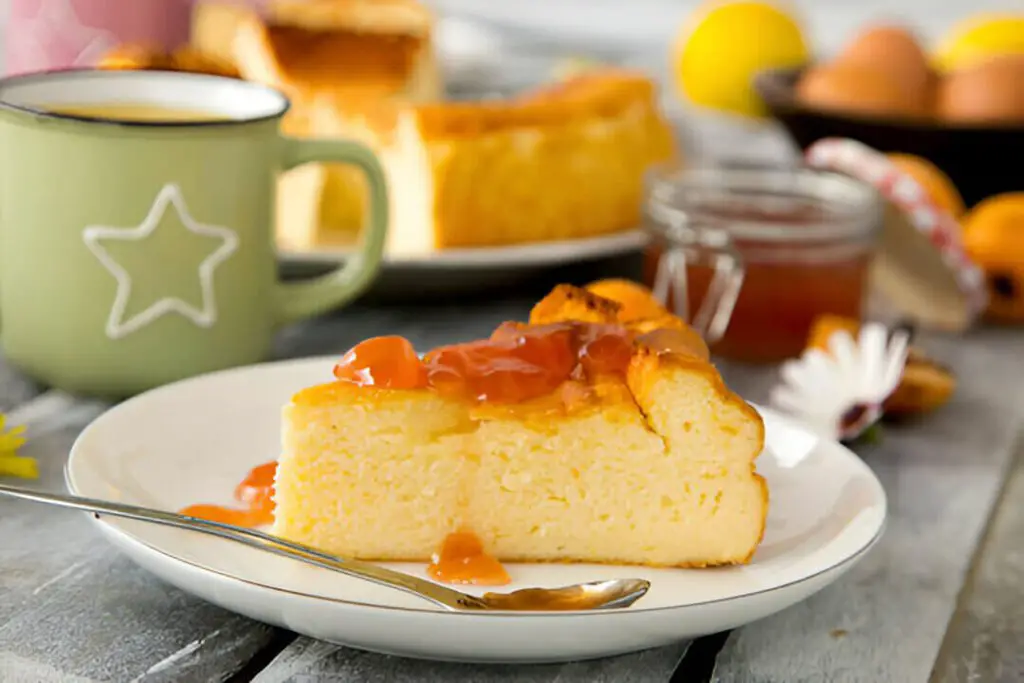Have you ever stumbled upon an odd-looking fruit that resembles a cross between a rose hip and a wrinkly apple? That’s the medlar, an ancient fruit that has been enjoyed for centuries but remains a mystery to many. With its unique appearance and intriguing flavor, the medlar is a true curiosity in the world of fruit.
If you’ve never had the chance to taste one, you might be wondering, “What do medlars taste like?” Well, get ready for a delightful surprise! This unassuming little fruit packs a punch of complex flavors that are sure to tantalize your taste buds.
Imagine biting into a sweet and tangy medlar, with notes reminiscent of caramelized apples, hints of cinnamon, and a touch of butterscotch. The texture is equally intriguing, transforming from firm and crunchy when underripe to deliciously soft and custardy when perfectly ripe.
Stick around as we discuss their unique taste, texture, and culinary potential. Get ready to discover a fruit that might just become your new favorite!
Appearance and Texture
At first glance, the medlar might not seem like the most appealing fruit. Its rough, brownish exterior is covered in a maze of wrinkles and creases, giving it an almost shriveled appearance. But don’t let its humble looks fool you—this unassuming exterior holds a secret delight within.
When you pick up a ripe medlar, you’ll immediately notice its unique texture. Unlike most fruits that start out firm and soften as they ripen, medlars follow the opposite path. In their underripe state, they are rock-hard, with a crunchy flesh that’s almost inedible. However, as they reach full maturity, medlars undergo a magical transformation known as “bletting.”
Bletting is a process similar to the ripening of persimmons, where the once-firm flesh breaks down into a deliciously soft, almost custard-like consistency. As the fruit blets, its skin takes on a deeper, richer shade of brown, and the wrinkles become more pronounced, giving it an almost leathery appearance.
When you slice into a perfectly bletted medlar, you’ll be greeted by a creamy, semi-liquid interior that oozes out of its papery skin. The flesh has a velvety smoothness that melts in your mouth, releasing a burst of complex flavors with each bite.
But the medlar’s texture isn’t just about the softness of its flesh. Scattered throughout the pulp are small, edible seeds that add a delightful crunch and textural contrast to the fruit’s otherwise silky consistency. These seeds are not only edible but also contribute a subtle nutty undertone to the medlar’s overall flavor profile.
What Do Medlars Taste Like?

While the texture of medlars is undoubtedly intriguing, it’s the complex and multifaceted flavor profile that truly sets this fruit apart. Imagine taking a bite of a sweet and tangy apple, infused with hints of caramelized sugar, spicy cinnamon, and a touch of butterscotch—that’s the essence of a perfectly ripe medlar.
At first taste, you’ll be greeted by a delightful sweetness that dances across your tongue. However, this sweetness is quickly balanced by a distinct tartness, reminiscent of the tanginess found in certain varieties of apples or even cranberries. It’s this delicate interplay between sweet and tart that gives medlars their unique and captivating flavor.
As you continue to savor the fruit, you’ll begin to detect deeper, more complex notes that unfold layer by layer. There’s an unmistakable caramel-like richness that lingers on the palate, akin to the flavors of baked apples or pears that have been slowly roasted with brown sugar and spices.
Complementing this caramelized sweetness is a warm, spicy undertone that evokes images of freshly grated cinnamon or perhaps even a hint of clove. These spicy notes add depth and complexity to the medlar’s flavor, creating a truly multidimensional taste experience.
And just when you think you’ve unraveled all the layers, a subtle nutty quality emerges, reminiscent of toasted almonds or even a touch of butterscotch. This nuttiness serves as a delightful counterpoint to the fruit’s overall sweetness, providing a grounding element that ties all the flavors together.
But perhaps the most intriguing aspect of the medlar’s flavor profile is its ability to evolve and change as the fruit ripens further. As the bletting process continues, the flavors become more concentrated and intense, with the sweetness taking on a richer, almost honeyed quality and the spicy notes becoming more pronounced.
Comparison to Other Fruits
At their core, medlars share some similarities with apples, particularly in their tartness and slight acidity. However, the flavor of medlars is often described as being more intense and concentrated than that of apples, with a deeper, richer sweetness that borders on caramelized.
Another fruit that medlars are sometimes likened to is the quince. Like quinces, medlars possess a distinctive tang and astringency when underripe, which mellows and transforms into a more complex, spicy-sweet flavor as they ripen and blet.
For those who have experienced the unique taste of persimmons, the flavor of medlars may ring a familiar bell. Both fruits undergo a similar bletting process, which results in a soft, custard-like texture and an intensification of their natural sweetness and spicy undertones.
In terms of the caramelized notes that medlars are known for, some liken their flavor to that of baked or stewed pears or apples, particularly when these fruits are cooked with brown sugar and warm spices like cinnamon and clove.
While medlars share certain characteristics with these more well-known fruits, they possess a distinct flavor profile that sets them apart. Their blend of sweetness, tartness, spiciness, and subtle nuttiness is truly one-of-a-kind, making them a culinary adventure for the senses.
Ripening and Storage
Enjoying medlars at their peak flavor and texture requires a keen understanding of their unique ripening process. Unlike many fruits that simply soften as they ripen, medlars undergo a transformation known as “bletting,” which is essential for achieving their signature custardy texture and concentrated flavors.
Determining when a meal is ready to eat can be a bit of a guessing game for the uninitiated. In their underripe state, medlars are rock-hard, with a tart and astringent flavor that can be quite unpalatable. It’s not until they’ve gone through the bletting process that they become truly enjoyable.
So, how can you tell when a medlar is properly bletted and ready to savor? The first telltale sign is its appearance. As the fruit blets, its skin will take on a deep, rich brown hue and become wrinkled and leathery. The flesh inside will also soften considerably, becoming almost liquid-like in texture.
Another indicator of a perfectly bletted medlar is its aroma. As the fruit ripens, it develops a warm, spicy fragrance reminiscent of cinnamon and cloves, with hints of caramelized sugar. This enticing aroma is a surefire sign that the flavors have concentrated and intensified, making the medlar ready for consumption.
If you’re still unsure, giving the fruit a gentle squeeze can provide further clues. A ripe, bletted medlar should yield slightly to gentle pressure, indicating that the flesh has softened to a custard-like consistency.
Once you’ve identified a perfectly ripe medlar, it’s important to handle and store it properly to ensure maximum flavor and freshness. Medlars are highly perishable and should be consumed within a few days of reaching their peak ripeness. Refrigeration can help extend their shelf life slightly, but it’s best to enjoy them as soon as possible.
For those who find themselves with an abundance of medlars, there are several ways to preserve their unique flavors. One traditional method is to make medlar jelly or cheese, which involves cooking down the fruit into a thick, spreadable preserve. Alternatively, medlars can be frozen or dried, allowing you to enjoy their flavors long after the season has ended.
Culinary Uses

While medlars may not be a common sight in most modern kitchens, these unique fruits have a rich culinary history that spans centuries and cultures. From ancient Rome to medieval Europe and beyond, medlars have been celebrated for their distinctive flavors and versatility in various dishes.
One of the most traditional ways to enjoy medlars is in the form of a medlar cheese or paste. This dense, spreadable preserve is made by slowly cooking down the fruit until it forms a thick, concentrated purée. Medlar cheese has a deep, caramelized flavor that pairs beautifully with cheese boards, toasted breads, and even as a filling for pastries or tarts.
In the realm of baking, medlars lend their unique sweetness and warmth to a variety of treats. They can be used to make delightful jams, jellies, and compotes, which can then be incorporated into cakes, scones, or even as a topping for ice cream or yogurt. The fruit’s natural spiciness also lends itself well to autumnal desserts like pies, cobblers, and crumbles.
For those seeking more savory applications, medlars can be used to add depth and complexity to sauces, chutneys, and glazes. Their tartness and subtle tanginess make them an excellent addition to meat dishes, particularly when paired with complementary spices like cinnamon, clove, and star anise.
In some culinary traditions, medlars are even used to make unique alcoholic beverages. In certain regions of Europe, for example, a medlar-based wine or liqueur is produced, capturing the fruit’s rich flavors in an adult beverage.
Beyond their use in traditional dishes, medlars are also finding their way into more modern and creative culinary applications. Adventurous chefs and home cooks alike are experimenting with incorporating medlars into everything from artisanal cheeses and craft beers to innovative cocktails and dessert creations.
Nutritional Benefits
In addition to their captivating flavors and culinary versatility, medlars also offer a range of potential nutritional benefits that make them a valuable addition to a healthy diet. While they may not be as widely celebrated as some mainstream fruits, these unassuming little gems pack a powerful punch when it comes to their nutritional profile.
One of the standout nutrients found in medlars is vitamin C. These fruits are an excellent source of this essential vitamin, providing a significant portion of the recommended daily intake in just a few servings. Vitamin C is a powerful antioxidant that supports a healthy immune system, aids in collagen production, and may even help improve iron absorption.
Medlars are also a good source of dietary fiber, which is crucial for maintaining a healthy digestive system and promoting feelings of fullness and satiety. The combination of soluble and insoluble fibers found in these fruits can help regulate bowel movements and may even contribute to lowering cholesterol levels and managing blood sugar levels.
Furthermore, medlars contain a variety of beneficial plant compounds, including phenolic acids and flavonoids, which are known for their potent antioxidant and anti-inflammatory properties. These compounds may help protect the body against oxidative stress and reduce the risk of various chronic diseases, such as heart disease, certain cancers, and neurodegenerative conditions.
In terms of their mineral content, medlars are a rich source of potassium, which plays a vital role in regulating blood pressure and supporting heart health. They also contain modest amounts of other essential minerals like calcium, magnesium, and iron, contributing to overall bone health, muscle function, and oxygen transport throughout the body.
While the nutritional benefits of medlars are certainly noteworthy, it’s important to remember that these fruits should be consumed as part of a well-rounded, balanced diet. Their unique flavors and potential health benefits make them a valuable addition to any dietary plan, but they should not be regarded as a panacea or a substitute for a diverse range of fruits and vegetables.
FAQs
What is the best way to eat medlars?
The most traditional way is to simply wait until the medlars are fully bletted (softened and browned) and then scoop out the custardy flesh with a spoon. However, they can also be used in baking, jams, chutneys, and more.
Do I need to peel medlars before eating them?
No, the skin is edible once bletted, so there’s no need to peel medlars. Simply remove the stem and calyx (leaf-like top) before eating.
How long does it take for medlars to blet?
It can take 2–6 weeks for medlars to fully blet and soften after being picked, depending on the conditions. Cooler temps slow bletting.
What does an unripe medlar taste like?
Unripe, hard medlars have an extremely tart, astringent, and unpalatable flavor. They must be allowed to fully blet before eating.
Can I eat medlar seeds?
Yes, the small seeds or stones inside medlars are edible and provide a nice crunch.
How should I store medlars?
Store unbletted medlars at room temperature, and they will gradually soften and blet. Refrigeration can slow bletting. Bletted medlars should be refrigerated and eaten within a few days.
Are medlars available year-round?
No, medlars have a relatively short season in late autumn/early winter in temperate climates. Their peak season is October–December.



